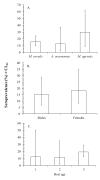Zoonotic Viruses in Three Species of Voles from Poland
- PMID: 33036253
- PMCID: PMC7599905
- DOI: 10.3390/ani10101820
Zoonotic Viruses in Three Species of Voles from Poland
Abstract
Rodents are known to be reservoir hosts for a plethora of zoonotic viruses and therefore play a significant role in the dissemination of these pathogens. We trapped three vole species (Microtus arvalis, Alexandromys oeconomus and Microtus agrestis) in northeastern Poland, all of which are widely distributed species in Europe. Using immunofluorescence assays, we assessed serum samples for the presence of antibodies to hantaviruses, arenaviruses and cowpox viruses (CPXV). We detected antibodies against CPXV and Puumala hantavirus (PUUV), the overall seroprevalence of combined viral infections being 18.2% [10.5-29.3] and mostly attributed to CPXV. We detected only one PUUV/TULV cross-reaction in Microtus arvalis (1.3% [0.1-7.9]), but found similar levels of antibodies against CPXV in all three vole species. There were no significant differences in seroprevalence of CPXV among host species and age categories, nor between the sexes. These results contribute to our understanding of the distribution and abundance of CPXV in voles in Europe, and confirm that CPXV circulates also in Microtus and Alexandromys voles in northeastern Poland.
Keywords: Alexandromys; CPXV; LCMV; PUUV; Poland; TULV; arenavirus; hantavirus; microtus; seroprevalence; vole.
Conflict of interest statement
The authors declare no conflict of interests.
Figures
Similar articles
-
Seroprevalence of Toxoplasma gondii among Sylvatic Rodents in Poland.Animals (Basel). 2021 Apr 8;11(4):1048. doi: 10.3390/ani11041048. Animals (Basel). 2021. PMID: 33917803 Free PMC article.
-
Identification of a novel hantavirus strain in the root vole (Microtus oeconomus) in Lithuania, Eastern Europe.Infect Genet Evol. 2021 Jun;90:104520. doi: 10.1016/j.meegid.2020.104520. Epub 2020 Sep 3. Infect Genet Evol. 2021. PMID: 32890767
-
In Vivo Characterization of a Bank Vole-Derived Cowpox Virus Isolate in Natural Hosts and the Rat Model.Viruses. 2020 Feb 20;12(2):237. doi: 10.3390/v12020237. Viruses. 2020. PMID: 32093366 Free PMC article.
-
Patchy Occurrence of Cowpox Virus in Voles from Germany.Vector Borne Zoonotic Dis. 2020 Jun;20(6):471-475. doi: 10.1089/vbz.2019.2530. Epub 2020 Feb 3. Vector Borne Zoonotic Dis. 2020. PMID: 32013767
-
Zoonotic reservoir of Babesia microti in Poland.Pol J Microbiol. 2004;53 Suppl:61-5. Pol J Microbiol. 2004. PMID: 15787199 Review.
Cited by
-
Grassland versus forest dwelling rodents as indicators of environmental contamination with the zoonotic nematode Toxocara spp.Sci Rep. 2023 Jan 10;13(1):483. doi: 10.1038/s41598-022-23891-6. Sci Rep. 2023. PMID: 36627309 Free PMC article.
-
Advancements and Challenges in Addressing Zoonotic Viral Infections with Epidemic and Pandemic Threats.Viruses. 2025 Feb 28;17(3):352. doi: 10.3390/v17030352. Viruses. 2025. PMID: 40143281 Free PMC article. Review.
-
The Invasive Bank Vole (Myodes glareolus): A Model System for Studying Parasites and Ecoimmunology during a Biological Invasion.Animals (Basel). 2021 Aug 28;11(9):2529. doi: 10.3390/ani11092529. Animals (Basel). 2021. PMID: 34573495 Free PMC article. Review.
-
Seroprevalence of Toxoplasma gondii among Sylvatic Rodents in Poland.Animals (Basel). 2021 Apr 8;11(4):1048. doi: 10.3390/ani11041048. Animals (Basel). 2021. PMID: 33917803 Free PMC article.
-
Candidatus Neoehrlichia mikurensis and Hepatozoon sp. in voles (Microtus spp.): occurrence and evidence for vertical transmission.Sci Rep. 2023 Jan 31;13(1):1733. doi: 10.1038/s41598-023-28346-0. Sci Rep. 2023. PMID: 36720952 Free PMC article.
References
-
- Luis A.D., Hayman D.T.S., O’Shea T.J., Cryan P.M., Gilbert A.T., Pulliam J.R.C., Mills J.N., Timonin M.E., Willis C.K.R., Cunningham A.A., et al. A comparison of bats and rodents as reservoirs of zoonotic viruses: Are bats special? Proc. R. Soc. B Biol. Sci. 2013;280:20122753. doi: 10.1098/rspb.2012.2753. - DOI - PMC - PubMed
Grants and funding
LinkOut - more resources
Full Text Sources


